
Embattled Karnataka Chief Minister B S Yeddyurappa late on Thursday night issued a press statement which stated that he will tender his resignation to Governor H R Bharadwaj on July 31.
His statement also mentioned that 'the time is not right as of now.'
During a top level meeting in Bengaluru, Yeddyurappa conveyed that he needs to upkeep the image of the Bharatiya Janata Party, and hence he is stepping down.
The influential Lingayat leader faxed a letter to BJP president Nithin Gadkari in which he stated, "I am a disciplined worker of the Bharatiya Janata Party. I have decided to tender my resignation to the post of chief minister as per the directions of the party."
"The month of Ashada will be over on 30th July, 2011, and on the new moon dayor Amavasya I will be tendering my resignation as chief minister on the forenoon of 31st July, 2011. I have consistently toiled for 40 years to build the party from scratch and have got the satisfaction of bringing the party to this level. It is my committed desire to work for the development of the party in the future also," he wrote in his message.
Also Read: Who will be the next CM of Karnataka?
BJP has also convened a legislature party meeting on Friday where they would decide on the next course of action.
Senior BJP leaders Arun Jaitley and Rajnath Singh are scheduled to visit Bengaluru on Friday and it is perceived that they would discuss and finally decide, on behalf of BJP's top brass, the next chief minister of the state.
The other issue that would be discussed will be the fate of the Reddy brothers, who are also named in the illegal mining report submitted by Karnataka Lokayukta Justice Santosh Hegde.
Meanwhile, Karunakar Reddy has decided to write to the Lokayukta seeking the removal of his name from the report.
Also Read: EXCLUSIVE! An excellent job done: Justice Hegde
Yeddyurappa's loyalists have, however, maintained that the decision to step down was his own and there was no pressure on him.
They also said that they would want to see him as the party president in the state.
Earlier, Karnataka Cabinet Minister V S Acharya had officially confirmed that Yeddyurappa has decided to tender his resignation.
However, Acharya, who is also in the running to become the next chief minister, at that time, did not specify the exact date as to when Yeddyurappa would tender his resignation.
Earlier reports claimed that Yeddyurappa did convey to the high command that he would step down provided his conditions are agreed to. These range from a say in the leadership to his own role in the party.
All Yeddyurappa said till now is that he will abide by the high command and there are certain issues that need to be looked into also.
After a long drawn meeting that was held through the day, sources said Yeddyurappa has agreed to resign provided he is made the chief of the state BJP. The most likely candidates to succeed him are Member of Parliament D V Sadananda Gowda or state Rural Development Minister Jagdish Shettar
The likes of Jagadish Shettar, V S Acharya, R Ashok have been meeting with senior BJP representatives from New Delhi on the issue of leadership change.
Karnataka Lokayukta Justice Santosh Hegde indicted Yeddyurappa among others in his report on illegal mining which was submitted on Wednesday, following which the BJP top brass asked the CM to step down.
Please click NEXT to read a profile of India's most controversial CM...

PTI adds: From a rice mill clerk and a farmers' leader to heading the first Bharatiya Janata Party government in the South, B S Yeddyurappa has been a master survivor emerging unscathed through much turbulence in his three years in office before the Lokayukta report on illegal mining scam did him in.
Bookanakere Siddalingappa Yeddyurappa, 68, who completed three years and two months in office as the first saffron party chief minister of Karnataka, ushered in a bumper harvest for the BJP in the state during the 2008 Assembly Elections.
Always sporting his trademark white safari suit, he was also briefly the chief minister in November 2007 before the coalition government with Janata Dal (Secular) collapsed following what he called "betrayal" by its leader and his predecessor H D Kumaraswamy.
Yeddyurappa, who had to juggle with one crisis or the other, has shown his skills as a political survivor, overcoming adversities emanating from within his own party and the combined Congress-JD(S) onslaught to oust him over alleged land scams.
Learning initial steps of leadership, development of mass base and human resource management from the Rashtriya Swayamsevak Sangh, it has been a fascinating journey dotted with many struggles for the devout Lingayat who believed that the gods are on his side.
He went on to apply these pragmatic lessons in action when he decided to lead various mass movements in the state, highlighting the problems faced by landless farmers and bonded labourers.
Yeddyurappa never misses an opportunity to visit temples when he is confronted by crisis but he was not lucky this time after he was severely indicted by Lokayukta Santosh Hegde on corruption charges. He was named after presiding deity of a Shaivite temple built by the saint Siddalingeshwar at Yedeyur, in Tumkur district.
...
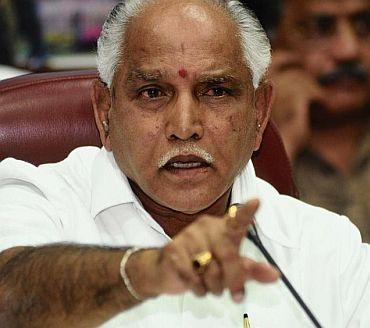
On a couple of occasions before his fate was almost sealed Yeddyurappa had the last laugh as he battled a spate of allegations of multi-crore land scams, nepotism and open violation of rules to favour his kith and kin.
Yeddyurappa managed to rally round his party MPs and loyalists after remaining defiant and keeping the top brass guessing on his moves when he was once asked to resign by the BJP leadership. Yeddyurappa, whose end as chief minister once seemed almost certain, with a smug opposition and his detractors within the party triumphant over delivering what they believed were deadly blows, has managed to carry on with the party asking him to stay.
A graduate in arts, Yeddyurappa once warned the central leadership that his exit would mean the end of the party government as well, a threat which made the senior leaders to do a rethink on their decision before to ask him to quit.
On many occasions he also brought out a powerful advantage, the Lingayat caste card. He belongs to the Lingayat community which constitute nearly a fifth of the population in Karnataka and also a strong support base for the BJP. He also managed to rally influential seers around him, and got them to support him.
...
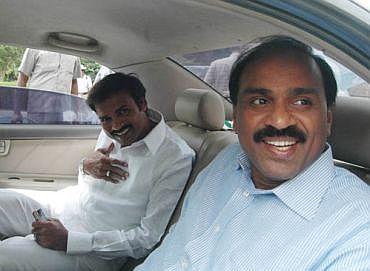
In November 2010, Yeddyurappa was alleged to have used his position as chief minister to unfairly favour his sons in the allotment of prime land in Bangalore triggering another round of crisis. On February 5, 2011, Yeddyurappa publicly declared his assets, and then challenged the opposition and the Congress to find any "black money".
Yeddyurappa, who began his rule on sticky wicket in May 2008 falling short of a majority in the Assembly, gathered a slender majority by luring opposition MLAs and independents who were made to resign and contest bypolls.
His gambit called 'Operation Lotus' paid off in enabling the BJP to secure the majority in the 224-member House. But the troubles did not seem to die down with the powerful Reddy brothers, ministers and mining magnates -- Janardhana and Karunakara -- launching a campaign for his removal.
The BJP high Command's intervention ensured his survival before another wave of dissidence engulfed his government.
...

As many as 11 BJP rebel MLAS and five independents withdrew support to his government, pushing it to a precipice. This too he survived, winning the trust vote twice -- the first one, carried by voice vote, called unconstitutional by Governor H R Bhardwaj forcing him to face another floor test, which he won by 106-100 votes.
Yeddyurappa, who was often at loggerheads with Bhardwaj, went down in the Indian Legislative history to be the only chief minister to survive two trust motions in a week's time.
Just as he seemed to have surmounted the crisis with the high court verdict upholding the disqualification of 11 rebel MLAs coming as a shot in the arm, trouble erupted again as the JDS levelled a series of allegations about land scams involving his family. He rose to prominence when he helped JD(S)' Kumaraswamy to bring down the coalition government of Dharam Singh of Congress.
...
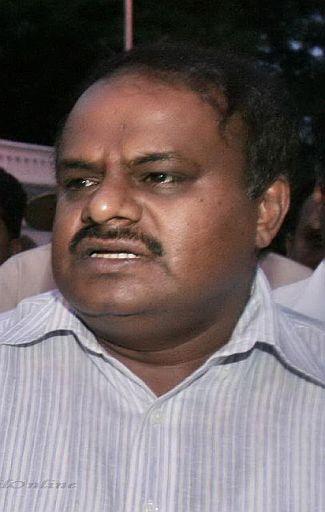
Kumaraswamy formed the government with the help of the BJP headed by Yeddyurappa. A deal was struck between the JD(S) and BJP, which specified that Kumaraswamy would be the chief minister for the first 20 months, after which Yeddyurappa would succeed him for the remaining 20 months of the tenure of the Legislature.
Yeddyurappa was nominated as the deputy chief minister as well as the finance minister in Kumaraswamy's government.
However, in October 2007, when Yeddyurappa's turn of becoming the chief minister was supposed to start, Kumaraswamy refused to resign from his post. This forced Yeddyurappa and all of the ministers from his party to resign and on October 5, he met the governor and formally withdrew the BJP's support from the government.
Karnataka was put under President's rule which was revoked on November 7. During the period of the President's rule, the JD(S) and the BJP decided to bury their differences and this paved the way for Yeddyurappa to become the Chief Minister.
Yeddyurappa was sworn in on November 12, 2007. However, JDS refused to support his government over disagreement on sharing of ministries which made him resign from his post on November 19, 2007.
...
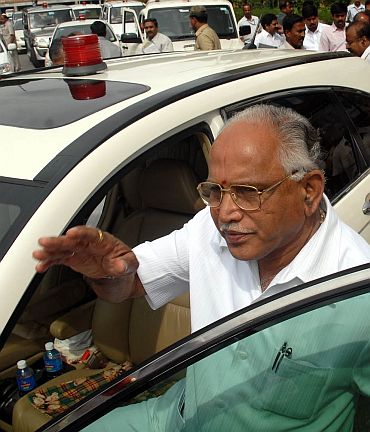
Born to Siddalingappa and Puttathayamma in Bookanakere in Mandya district in the state on February 27, 1943, the BJP leader lost his mother when he was just four-years-old.
However, his determination to rise above all odds saw him overcoming the personal tragedy and move on in life.
Yeddyurappa, was elected as President, Shikaripura Taluk Jana Sangha in 1972, marking his debut in public life. His leadership skills got an early start when he became the secretary of the Janata Party in 1977. His forte in taking up peoples' issues was amply illustrated when he spearheaded a team of 1,700 bonded labourers to Shimoga deputy commissioner's office demanding the release and rehabilitation of such labourers.
A farmer himself, it was under his leadership that the movement for upholding the rights of ryots who were cultivating on government land unauthorisedly gained momentum.
...
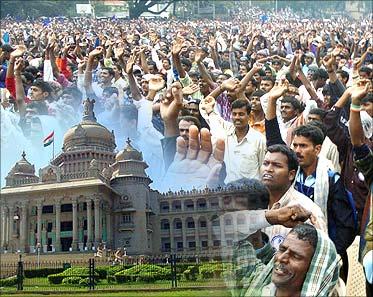
This missionary zeal brought some sufferings too. He was imprisoned during Emergency in India between 1975 and 1977 and spent his days in Bellary and Shimoga jails.
In 1965, he got a job of a first-division clerk in the social welfare department but instead shifted to Shikaripur where he joined as a clerk at his relatives' rice mill. In 1967, Yeddyurappa married Mythradevi, the daughter of the owner of the rice mill Veerabhadra Shastri.
He later set up a hardware shop in Shimoga. Yeddyurappa's true political career began when in 1983 he was first elected to the assembly and he has represented Shikaripur constituency from then on for five times. His leadership skills were recognised by the central leadership of BJP and he was made the president of the state unit twice.
He was also the national secretary in 1992. The "yatri" in him is always at work. To improve the lives of marginalized, poor and gullible farmers, Yeddyurappa has taken up many yatras through the entire length and breadth of the State. Born on February 27, 1943 Yeddyurappa has two sons and three daughters.
In 2004, his wife died after drowning in a well under mysterious circumstances. No case was registered.
With inputs from PTI